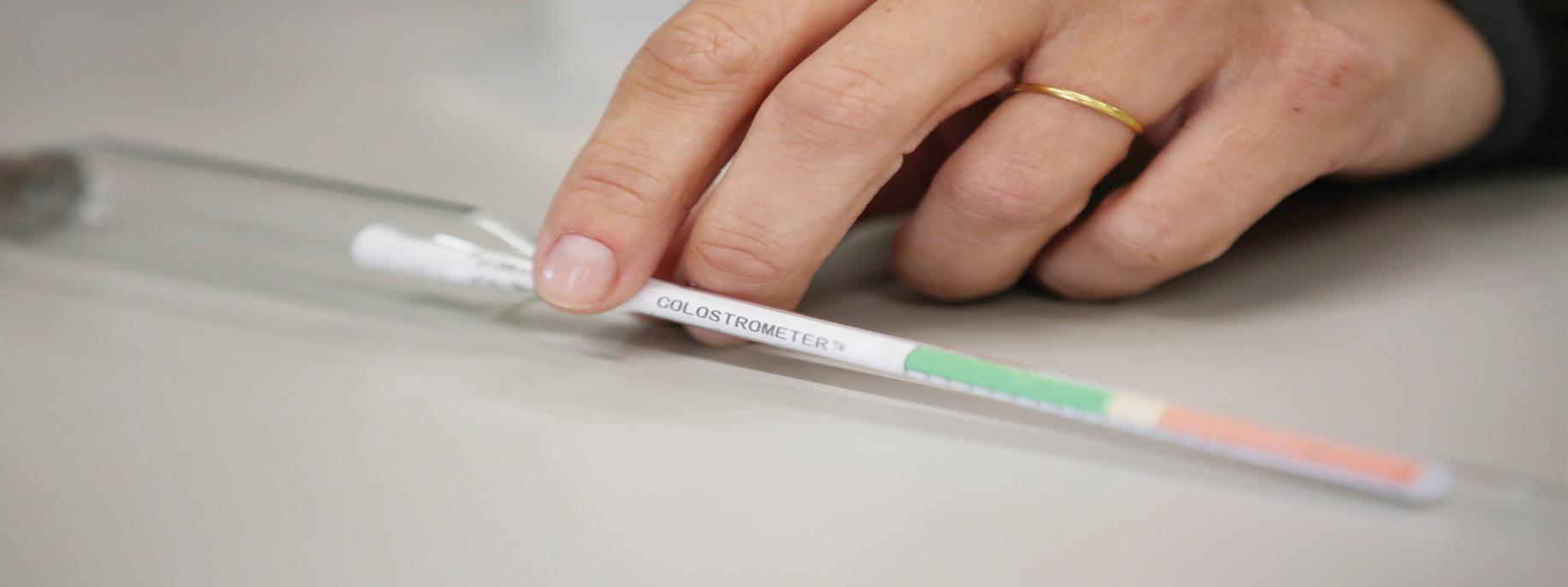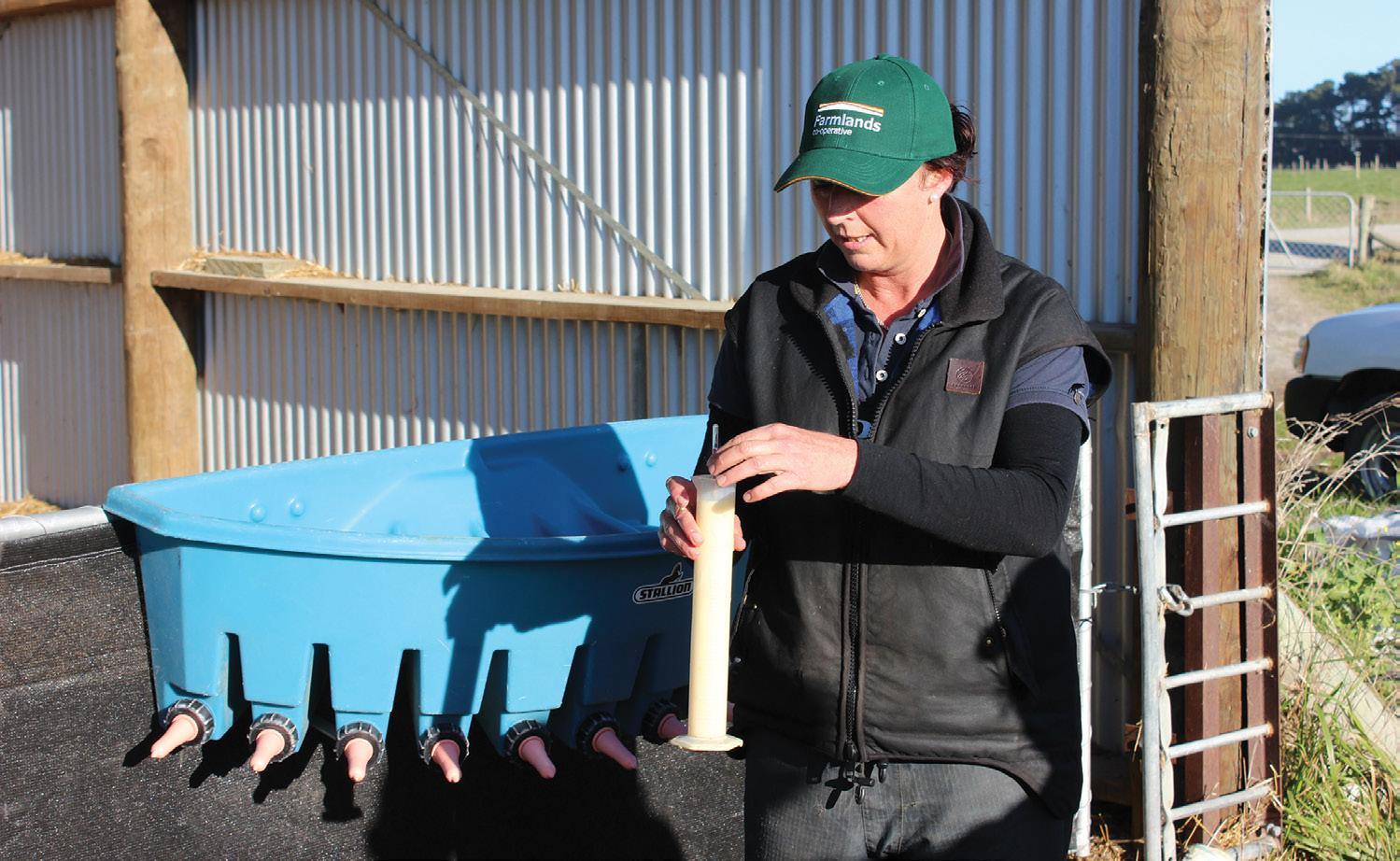
5 minute read
Passing the test
Colostrum has to be measured to gauge the quality - the colour in the bucket does not indicate if its gold or not.
Words by: Anne Lee
Liquid gold all too often doesn’t live up to expectations because of poor handling or simply collecting the wrong thing.
NRM calf rearing expert Karen Fraser says that first-milking colostrum is aptly named gold colostrum because its value to the calf and the farm business makes it almost worth its weight in the precious metal.
“There are so many studies that show what a huge difference it makes to the health and longevity of animals that go into the herd.
“Any time spent making sure you’re feeding the best quality to calves quickly enough will pay for itself over and over again.”
All care might be taken in the calf sheds but getting first-milking colostrum packed full of immunoglobulins (IgG) must be top-of-mind right from just prior to cows calving.
The more frequent the calf pick-ups the faster cows are milked and calves fed. She advises two to three pick-ups a day.
At the first milking it’s imperative that good hygiene and best practice colostrum handling are carried out.
Karen says one of the mistakes often made when milking a number of first
Karen Fraser measures some colostrum with her colostrometer.

milking cows into a vat or larger tank is that the milk line isn’t purged well enough.
“That milk from second, third and fourth milkings might be thought of as colostrum but it’s actually transition milk that’s going to dilute gold colostrum, even if it’s just what’s left in the line.
“It may still have a level of antibodies good for young calves but it’s not good enough for newborn animals.”
The other issue is bacteria and keeping them out of gold colostrum. Make sure the udder is clean, the lines and the vessel the colostrum is collected into are clean, and that it’s then stored so bugs can’t get into it, she says.
“Don’t leave it sitting around. If you’re not going to use it as soon as possible after collecting it - within that day’s feeding – refrigerate it, use a colostrum keeper, or freeze it.”
Pasteurisation is also becoming more popular.
Karen Fraser with calf explaining the suck reflex.

COLOSTROMETER AND REFRACTOMETER BRIX TEST
There are two common ways of measuring gold colostrum quality and neither involves simply looking at the colour.
“Just because one bucket is a much deeper gold than the next doesn’t necessarily mean it’s better quality – there’s no definite relationship with antibody levels.”
Instead, a Colostrometer or refractometer should be used.
Both are backed by scientific research and numerous peer reviewed papers, calibrating levels of IgG with the measurements they take.
A Colostrometer essentially measures the thickness of the liquid using specific gravity.
The more IgG, the denser the colostrum.
The Colostrometer is a glass tube with a bulb at the end. When it is placed vertically into the colostrum and let go, it will float – the higher it floats the more IgG and the better the quality.
A coloured, calibrated scale on the Colostrometer indicates the quality. The lower on the green section the surface line of the colostrum sits, the higher the quality.
However, the temperature of the colostrum will affect the reading – the warmer it is the lower down the Colostrometer will float in the colostrum, which may give a falsely low reading .
Likewise the colder it is, the thicker it becomes, which may give an inaccurately high reading.
If it’s freshly collected it may be frothy, with air bubbles that will also give a falsely low reading. Leave it for 20 minutes to get any air out.
Because it’s glass, care also has to be taken not to break it.
Refractometers are more robust and require only a drop of colostrum.
They are calibrated to various scales, and for colostrum it’s the Brix scale with units as a percentage.
They use light and measure how much a light beam passing through the substance is bent, or refracted.
Past research has found a strong correlation between this light refraction measure and the amount of protein in colostrum, which in turn has a strong correlation with the amount IgG.
Pasteurising colostrum
Pasteurising colostrum can not only kill bacteria picked up after first milking it can also help reduce infection loads from diseases such as Johne’s and M.bovis.
But it needs to be done slowly at a low heat to avoid killing off valuable antibodies.
Cambridge vet Ursula Hayward and husband Mark have, through their Antahi Innovations company, developed a new pasteurising system that also doubles as a colostrum warmer.
Ursula says it works essentially as a water bath with a water heater and pump that gently warms the valuable colostrum with a constant-flow moving around specially designed “thin skinned” bags that the colostrum can be stored in and fed from.
Called the Trusti Pasteur, Ursula says, it can accurately get the colostrum to the 60 degrees Celsius temperature and hold it there for an hour to effectively but gently pasteurise it.
It can also warm the colostrum to 42 degrees Celsius from frozen in 20 minutes for feeding to young calves.
Ursula says studies have shown reducing bacterial loading can significantly help young calves absorb the antibodies in the colostrum because bacteria can both interfere with the antibodies and damage calf gut cells the antibodies pass through.
As a way to simply warm the colostrum it’s also a more practical and safer system so that young calves have a more pleasant feeding experience.
Ursula says she’s already had international interest in the system, which is a lot more affordable than many European-based designs.
The aim is to have a Brix score of 22% (equivalent to 50mg/ml concentration) or more for good quality colostrum.
Colostrum measuring less than 22% will mean you will have to use a larger volume of that colostrum to get enough IgG into newborn calves within the 12 hour time period.
The face of the refractometer must be clean or it will distort the reading.










